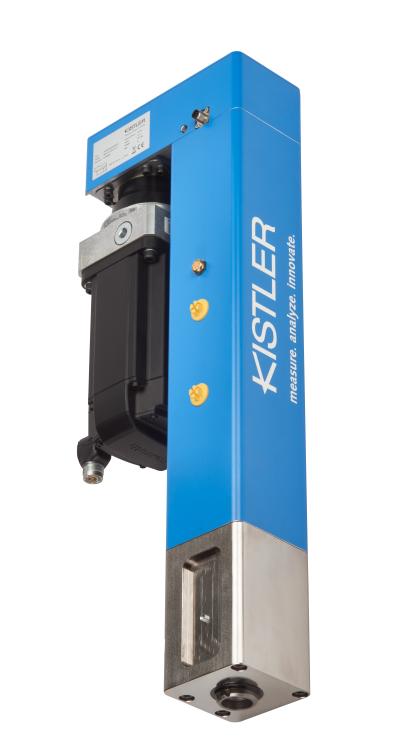
Kistler is adding a compact, weight-optimized system to its portfolio: the new NCFC electromechanical joining module. This is a highly suitable solution for clinching and riveting applications, and also for assembly and joining processes that require force-displacement monitoring. Another highlight of the new NCFC servo press: it needs very little installation space, so weight and center of gravity design are optimized – particularly for robot arm applications.
Clinching (also known as press-joining) is an efficient and reliable joining process that is becoming increasingly attractive to industrial manufacturers because it requires no additional components such as rivets or bolts. And unlike drilling or welding, clinching does not generate any heat input. Clinching requires less energy and maintenance effort than spot welding; depending on the material and process, the strength values of clinched joints are often equal or sometimes even higher, and the processes can also be controlled with greater ease and accuracy.
Kistler presents in cooperation with BTM the first ever electromechanical joining module that is specifically optimized to meet the requirements of the clinching process. Thanks to the combination of Kistler technology with BTM's application know-how in clinch tooling and pliers, customers benefit from a servo press based on cutting-edge technology that offers high-precision, energy-efficient part joining with assured quality. Due to the compact lightweight design the servo press is ideal for use on robots and stationary or mobile portals. It has better dynamics than systems with comparable weight and similar dimensions. The optimized design allows short distances between workstations (small center distance). Thanks to the new hybrid cable solution, installation of the servo press has become even faster and easier to handle. Visualization, control and documentation with the proven maXYmos NC process monitoring system does not require an additional industrial PC. Overall, the new NCFC electromechanical joining module allows for improved quality and lower consumption of resources, as well as reducing CO2 emissions compared to conventional systems.
The future of clinching is electromechanical
The outcome of the collaboration between clinching specialist BTM and the measurement and joining technology experts at Kistler is an exceptionally advanced solution that will benefit customers across the globe. BTM has earned worldwide renown with its flexible, customized solutions and has accumulated decades of experience with mechanical joining solutions such as clinching and self-piercing riveting. BTM's expertise played a key part in the cooperation partnership with Kistler, providing an ideal solution for customers to switch to electromechanical clinching.
An electromechanically operated clinching system offers significant energy savings as compared to pneumatic or pneumohydraulic alternatives. In this solution, the servo press is controlled by the proven maXYmos NC process monitoring system from Kistler. With continuous force-displacement monitoring by the integrated sensor, positions can be approached reliably, flexibly and at high speed; the solution also includes an additional traverse mode with safely reduced speed. The new system ensures complete control and transparency for each individual production step at all times; deflection compensation for the mounting bracket also allows very precise setting of the residual base thickness (as the quality characteristic).
Advancing the digitalization of production processes
The new NCFC (2163A) joining module from Kistler will be offered in two versions with nominal joining forces of 55 kN and 80 kN respectively. As well as the robot arm application, the NCFC servo press can also be operated as a stationary version or as part of a complete clinching system from BTM.
Clinching delivers major benefits in line with key industrial trends: resource and energy efficiency, transparency, and automation – as well as extensive possibilities for joining components made of different materials. Given these advantages, electromechanical joining systems are set to see significant growth in sectors such as electrical engineering, white goods, refrigeration and air conditioning technology. The world's mechanical engineers and manufacturers can now use the clinch solution from BTM and Kistler to boost the economic efficiency, quality and transparency of their assembly processes – and the digitalization of clinching marks another step along the road to Industry 4.0.
Contact Details
Related Glossary Terms
- numerical control ( NC)
numerical control ( NC)
Any controlled equipment that allows an operator to program its movement by entering a series of coded numbers and symbols. See CNC, computer numerical control; DNC, direct numerical control.
